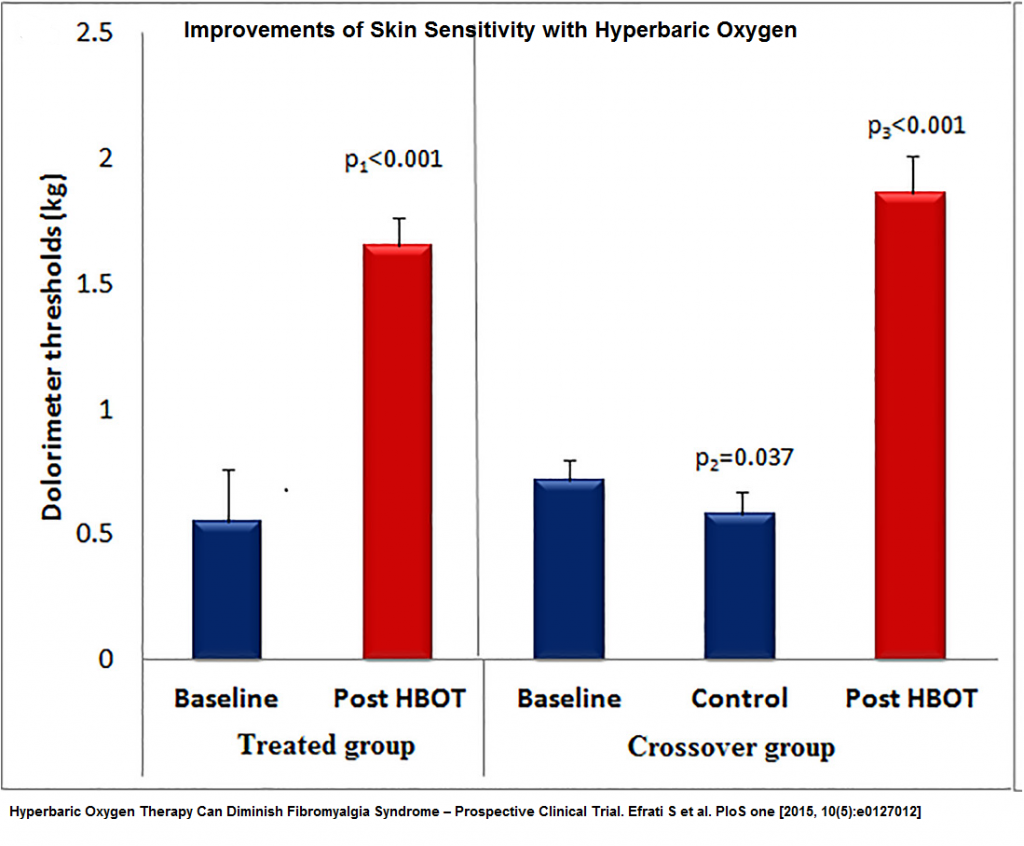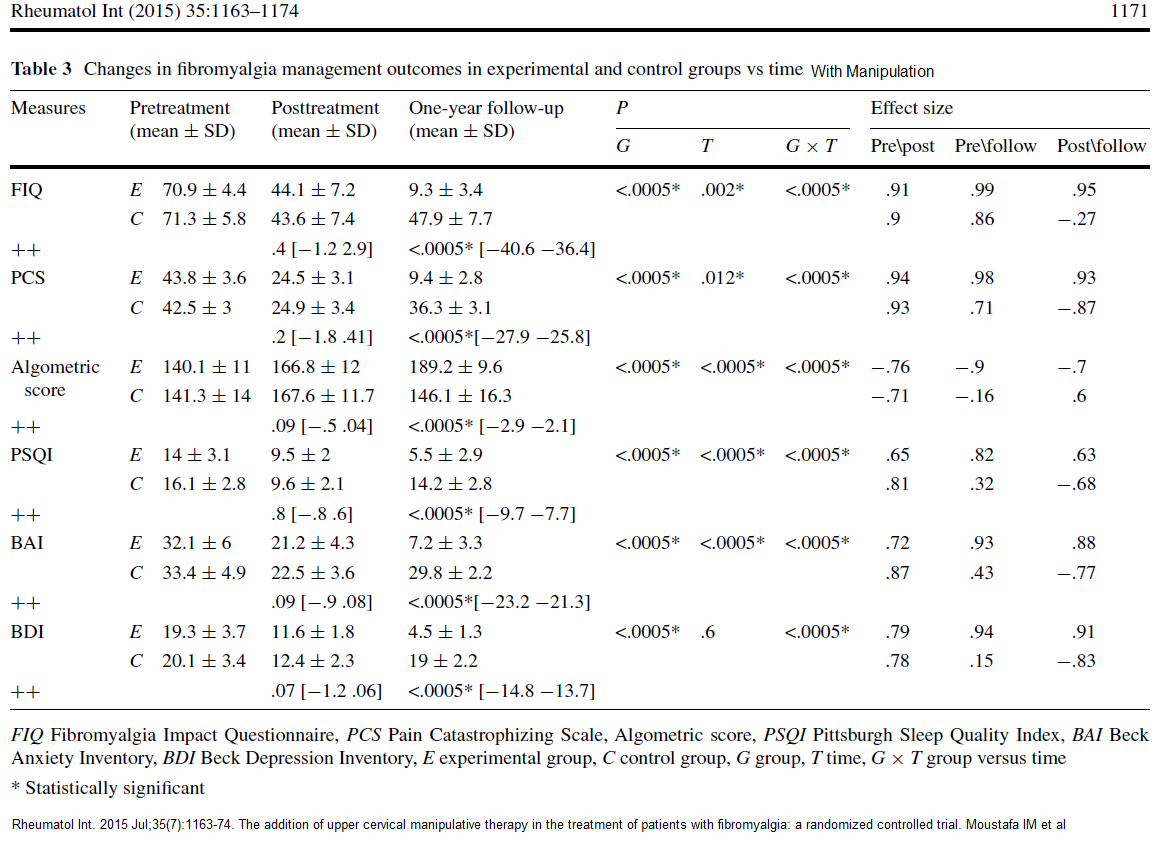Two important studies on approaches to help Fibromyalgia (FM) have omitted changes in Visual Analog Scale (VAS) readings in their results. Giving reading of skin tenderness adds differences with each muscle site tested and can exaggerate total difference. Suspicion is, there were not significant changes as this is the hardest measure to show benefit – yet the most important.
Hyperbaric Oxygen Therapy Can Diminish Fibromyalgia Syndrome – Prospective Clinical Trial
Efrati S, Golan H, Bechor Y, Faran Y, Daphna-Tekoah S, Sekler G, Fishlev G, Ablin JN, Bergan J, Volkov O, Friedman M, Ben-Jacob E, Buskila D.
PloS one [2015, 10(5):e0127012]
http://www.plosone.org/article/fetchObject.action?uri=info:doi/10.1371/journal.pone.0127012&representation=PDF
I put in all the authors because the last one D. Buskila is world famous for his insights in post traumatic Fibromyalgia:
Curr Rheumatol Rep. 2000 Apr;2(2):104-8.
Musculoskeletal injury as a trigger for fibromyalgia/posttraumatic fibromyalgia.
Buskila D(1), Neumann L.
http://www.ncbi.nlm.nih.gov/pubmed/11123046
This adds considerable credibility to the article.
- 40 sessions 5 days a week, 90 minutes with 100% oxygen
Results:
- Brain changes are documented as well
- Sadly, the control group was given not treatment, not allowed to have any placebo – hope effects, and not allowed several hours off work a day where one could be in company of other sufferers. Heck, even the use of 20 minutes of music twice daily can reduce symptoms by up to 50% in one study so results can be very confusing.
Music Therapy in Chronic Pain May Drop Pains by 50% 0ver 2 Months
http://painmuse.org/?p=459
Next study:
Rheumatol Int. 2015 Jul;35(7):1163-74. doi: 10.1007/s00296-015-3248-7.
The addition of upper cervical manipulative therapy in the treatment of patients
with fibromyalgia: a randomized controlled trial.
Moustafa IM(1), Diab AA.http://www.ncbi.nlm.nih.gov/pubmed/25782585
- The upper cervical spine is implicated in Fibromyalgia – thru issues such as subclinical spinal stenosis and chairi. Stimulation of the region electrically can reduce FM pains
Plazier, Mark, et al.
Occipital Nerve Stimulation in Fibromyalgia: A Double‐Blind Placebo‐Controlled Pilot Study With a Six‐Month Follow‐Up.”
Neuromodulation: Technology at the Neural Interface 17.3 (2014): 256-264.
Decrease in pain intensity (39.74%) on visual analogue scale (VAS; p < 0.001) and fatigue by 44%
( notice above, this group is not afraid to use VAS pain scales)
andPlazier, Mark, et al.
C2 Nerve Field Stimulation for the Treatment of Fibromyalgia: A Prospective, Double-blind, Randomized, Controlled Cross-over Study.
Brain stimulation (2015).
http://www.utdallas.edu/~sxv140030/papers/Plazier_et_al._in_press_Occipital_nerve_stimulation_in_fibromyalgia_a_double_blind_placebo_controlled_pilot_stury_with_a_six_month_follow-up._Neuromodulation.pdf33% reduction in pain
- Manipulative therapy:
Non‑thrust mobilization: “With the patient in the prone position, the therapist appliedone 30-s bout of left-sided unilateral posterior–anterior mobilization to the C1-2 motion segment as described by Maitland. This same procedure was repeated for one 30-s bout to the right atlantoaxial joint.”
High‑velocity low‑amplitude (HVLA) thrust manipulation: – “With the patient in the supine position, the therapist contacted the left posterior arch of the atlas with the lateral aspect of the proximal phalanx of the left second finger using a “cradle hold.” To localize the forces to the left C1-2 articulation, the secondary levers of extension, posterior–anterior shift, ipsilateral side-bend, and contralateral side-shift were used. While maintaining the secondary levers,
the therapist applied a single HVLA thrust manipulation to the left atlantoaxial joint using the combined thrusting primary levers of right rotation in an arc toward the under-side eye and translation toward the table. This process was
repeated using the same procedure but directed to the right C1-2 articulation.” - 3 times a week over 1 month giving 12 sessions
Results are impressive:
- One factor that I think is very important, is the benefits to sleep – neck less stiff and sore – sleep better – everything gets better However, a difference in the algometric scale of 166.8 from 140.1 is a 16% change which would drop pains from 7/10 to 5.9 – a 1.1 drop. This is still clinically relevant but need at least 1 to be relevant. Mind you, duloxetine barely gets more than 1.2 drop. It would have helped if they gave VAS reading but those are the hardest to achieve so they are often left out.
Comment – I believe that there are specific mechanical sites that pay a key role in FM –
- subocciptal
- C4/5/6 facets referring to shoulder tip and shoulder girdle
- shoulder tip
- T4 syndrome often resulting from tight pectoral/serratus anterior muscles
- Maigne’s Thoracolumbar syndrome referring to upper buttocks
- sacral torsion and low back pain – a talk in itself
- piriformis syndrome
- gluteus medius pains
- restless legs and tibialis posterior muscles
I am too conservative to do manipulations to upper neck though I could see its use for proof in this study. I transverse stretch the splenius capitus and strip stretch suboccipital, then do muscle energy techniques suboccipitally and myofascial release and manual cervical traction. If bad, I will Dr. Chen Gunn’s Intramuscular stimulation (IMS) to triggers areas and massage out.


